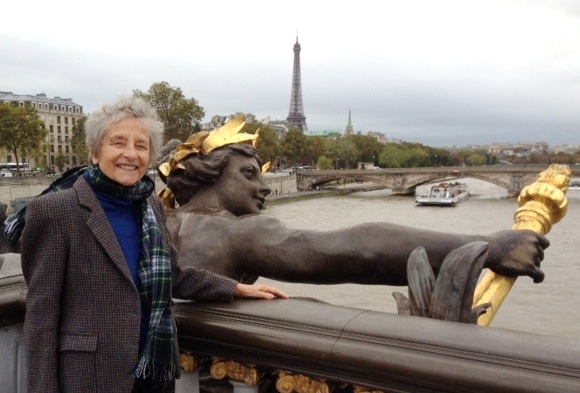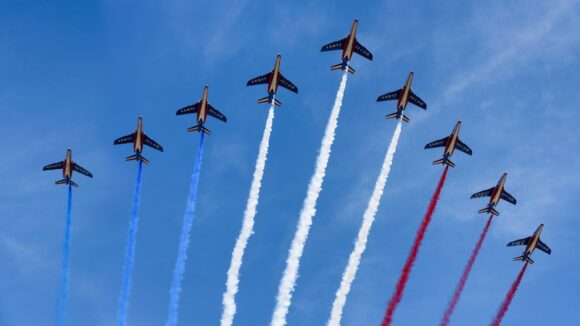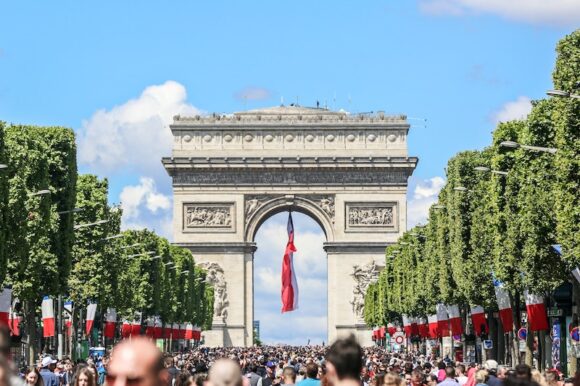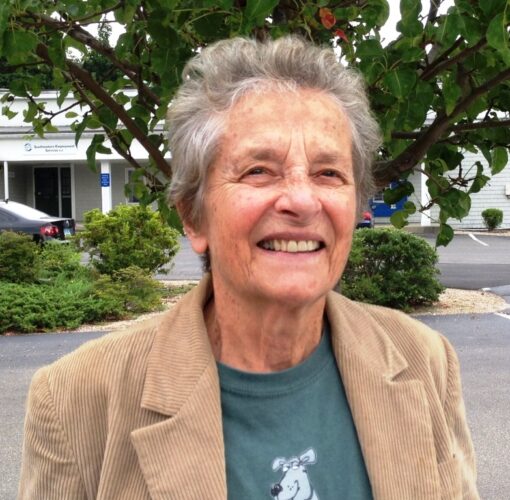
Watching the 14th of July defilé [parade] is a well-anchored tradition for the French.
This year, as always, it was a two-hour impeccably choreographed event. Each French president takes it very seriously since it is an opportunity to display the military profile of the country, the vision for its future, as well as the latest technology, and to reaffirm the fact that strategic solidarity with European allies has become a priority.
The tradition of a military parade on France’s national day — July 14th or Bastille Day — dates back to 1919, when troops marched to celebrate the victory at the end of the Great War. In its early days, the defilé took place on the Longchamp hippodrome in the Bois de Boulogne in Paris.
Today the Champs Elysées offers a majestic setting with the perspective of the modernistic sky scrapers of la Défense district, the Arc de Triomphe and the wide avenue leading to the Place de la Concorde. The TV Channel France 2 cameraman played with the hieroglyphs of the Luxor obelisk, which stand at the center of the square, before zooming down to the bleachers where President Macron, his wife Brigitte and the official personalities were seated.
Prime Minister Narendra Modi of India was on a state visit to France and a delegation of Indian troops was the first to march down the avenue. I was struck by their very unusual gait. They were not just swaying their arms back and forth but it looked as though those very arms were going full circle.

The military parade has a special significance for me – an officer’s daughter and the sister of an Air Force General – especially as the kickoff was done in synch with an air parade. To the delight of the crowd, two small planes flew one on top of the other, with the top one upside down.Those planes are part of the Air and Space acrobatic team of the French Air Force, who have been world champions since 2022.
The “Big Nine” of the Patrouille de France gave a spectacular performance: nine Alphajets flying in perfect unison with tricolor smoke trailing behind them. The Patrouille has existed since 1953 and is based in Salon-de-Provence.
In all, more than 6o planes took part in the event: 26 Rafales, Mirages, and Falcon aircraft and 28 helicopters, including two light helicopters Guépard. The latest generation F4 Standard Rafale demonstrate improved connectivity with satellite and intra-flights links.
The modernization of the technology was developed during the French-led Operations Serval and Barkhane in the Sahel region since 2013.
Polyvalence, info-valorization and integration principles were on display in the new military equipment such as Leclerc tanks, Cesar canons, five-tons heavy tanks, 2022 hussards for infiltration and exfiltration of intelligence, armored vehicles essential for logistics in delivering troops, and equipment, such as anti-personnel mines, anti-ballistic missiles and trailers with drones .
France already has eight aircraft carriers — the largest one being the Charles de Gaulle — along with 10 nuclear submarines.
The parade was an opportunity to display the latest equipment from the defense maritime system in existence from Belgium to both Cherbourg and Mont Saint Michel, as well as for the nuclear approach that was developed during the Harmattan Operation in the war against Libya in 2011.
More than 6,500 men and women marched down the Champs Elysées. Their superb performance required at least six hours of rehearsals. The graduates of the élite military schools like Ecole Polytechnique, Saint Cyr-Cohêtquidan (founded in 1802 by First Consul Napoleon Bonaparte in Fontainebleau), Ecole de l’Air (created in 1933 and the oldest air force academy in the world), and Ecole Navale always have a special place in the military parade.
Marching also were some of the 800,000 firefighters who are engaged in the fight against the growing danger of forest destruction. Thirty thousands of them are volunteers. In February 2023, they took part in a rescue mission to Turkey and Syria after the earthquake which killed 60,000 people. France uses 21 bi-engine bombers , including 12 Canadairs ( pioneered by Canada) to fight the fires from the air.

La Légion Etrangère [Foreign Legion] always stands out on the 14th of July. It is the only group which has its own band. The pace is strikingly slow. One soldier swirls his baton high in the air. The men from many nationalities are dressed completely in white. Some wear leather aprons. A soldier with a beard longer than his companions’ holds a dog on a leash.
The colorful contingent of the Garde Republicaine , accompanied by the noise of the horses’ hooves on the pavement is most popular with the public. Created in 1802 by (again) Bonaparte – this special corps of 3,300 men and women is part of the Gendarmerie Nationale.
The defilé ended up with quite a moving choreography of young people positioned to form a Croix de Lorraine – the declared symbol of the Résistance by General de Gaulle in 1940. The commissar of the armies read the letter of Jean Moulin, hero of the French Underground.
And finally, the crescendo of the haunting “Chant des partisans, ” a 1828 Russian melody imported by a Russian emigré to France in 1917, rose over the ceremony.
The 2023 ceremony was indeed bristling with the symbolism of France’s destiny and its De Gaulle heritage.
Editor’s Note: This is the opinion of Nicole Prévost Logan.

About the author: Nicole Prévost Logan divides her time between Essex and Paris, spending summers in the former and winters in the latter. She writes an occasional column for us from her Paris home where her topics will include politics, economy, social unrest — mostly in France — but also in other European countries. She also covers a variety of art exhibits and the performing arts in Europe. Logan is the author of ‘Forever on the Road: A Franco-American Family’s Thirty Years in the Foreign Service,’ an autobiography of her life as the wife of an overseas diplomat, who lived in 10 foreign countries on three continents. Her experiences during her foreign service life included being in Lebanon when civil war erupted, excavating a medieval city in Moscow and spending a week under house arrest in Guinea.